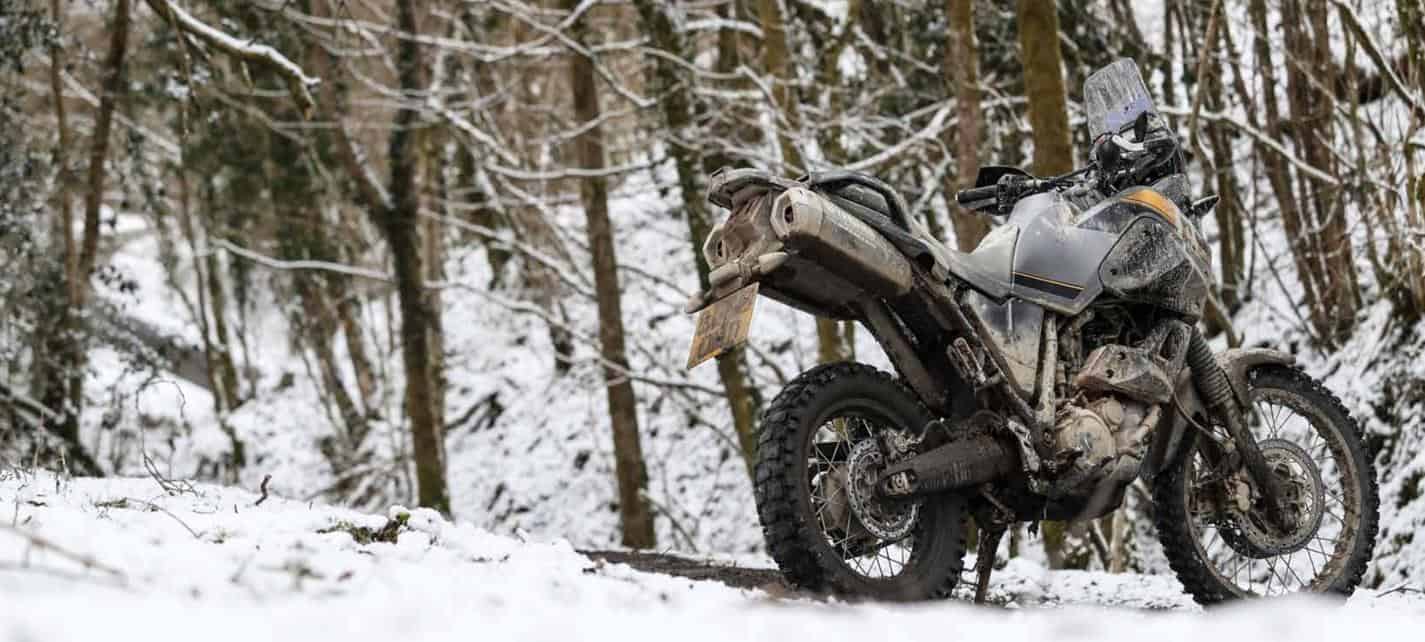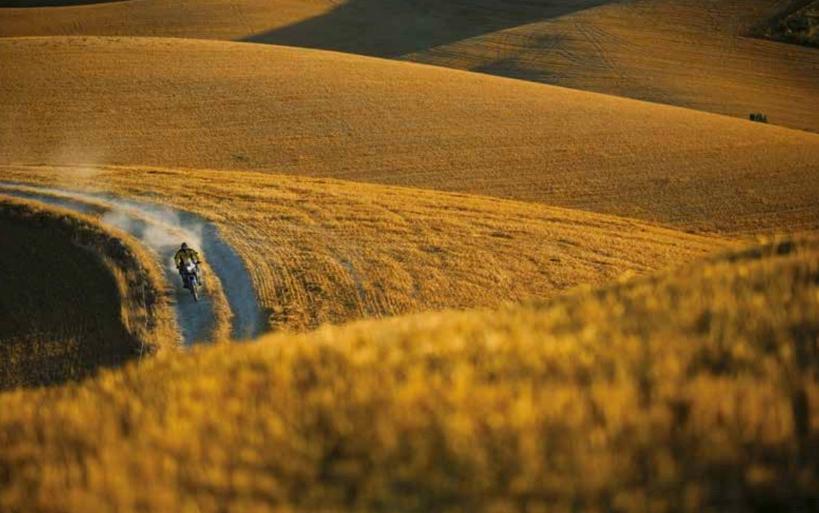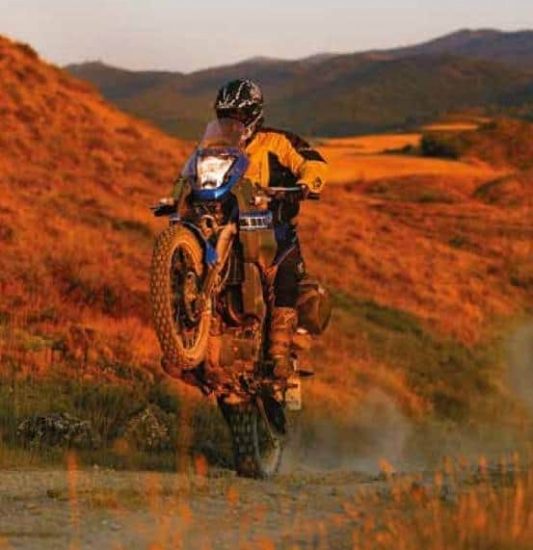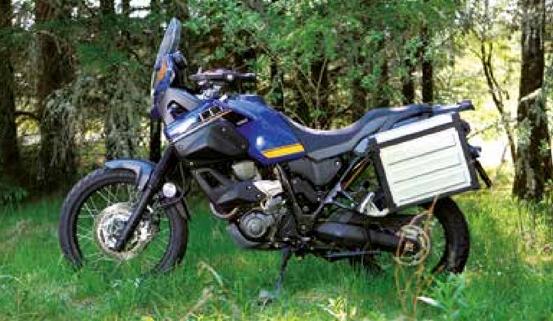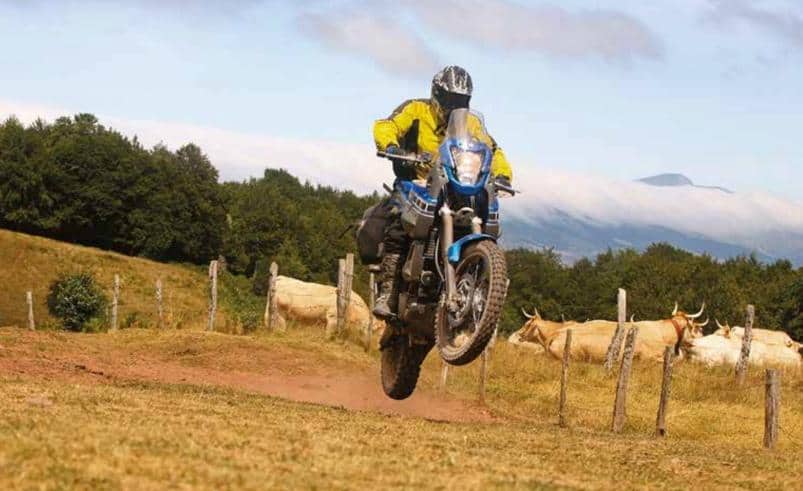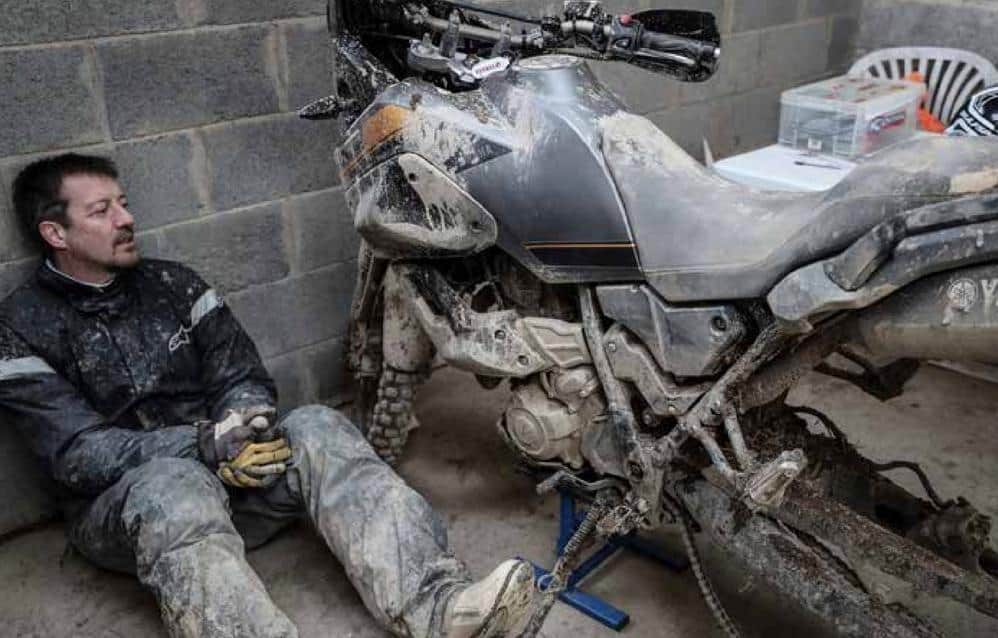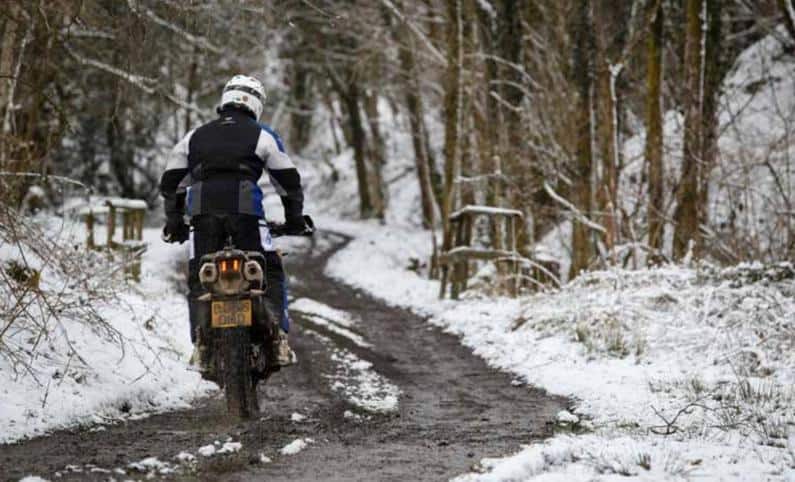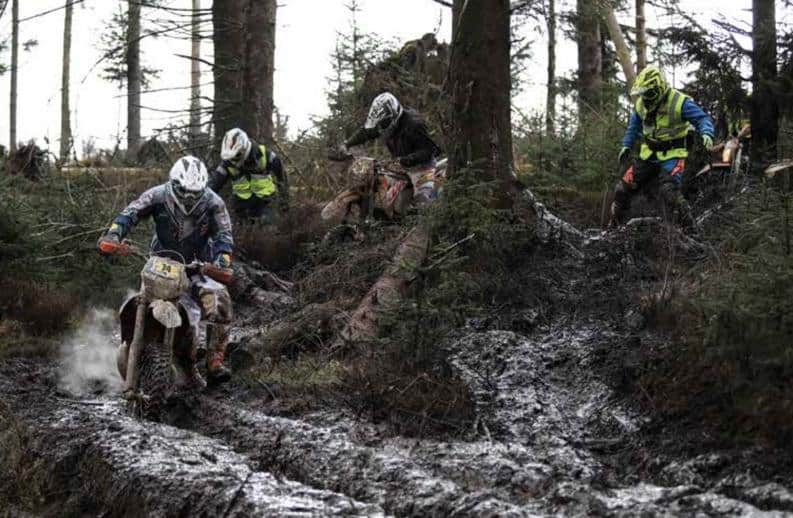We’re still waiting for the next generation 700cc Project T7 (Ténéré) to become a production machine – and it can’t arrive too soon – but in the meantime we thought we should honour this one last time the last Ténéré, the XT660Z (2008-), for it has been something quite special.
Words: JB Images: JB, James Barnicoat, Alex Waters & others
Despite over the years only ever enjoying a few sporadic rides on Yamaha’s XT660Z Ténéré, here at RUST it’s been on our list of top-10 adventure bikes (possibly top-five) ever since its arrival in 2008. It’s not perfect (what bike is?) but Yamaha really did get so close to answering a lot of long distance road-lesstravelled travel riders’ prayers with this model. An engine of admirable simplicity, reliability and durability. A rock-solid chassis. All day ergos. Mega fuel range. And real off-road chops (although she’s a heavy beast if you do get stuck in a mud hole). So many adventure bikes answer to what we want, but the Ténéré is all about what we need. It takes some pluck to adopt the KISS principle in bike design, but Yamaha gave us a truly iconic and worldcircling success with the Ténéré. So here’s our run down of what we think are its ten strongest attributes.
1 It’s a proper – simple – adventure bike
Today, the motorcycle market is inundated with high-tech offerings under the adventure banner. No question, they’re great bikes, but few hit the brief of a travel bike with such honesty as the Ténéré does. Modern adventure bikes have become mobile Christmas trees given the amount of electronic gizmos they now sport. Great, so as long as they don’t go wrong – and positively disastrous if they go wrong outside of the first world. So in the (real?) world of back-to-basics fix-it-witha-hammer travel riding the Ténéré is almost unique. Yeah, we said almost…
2 Long-range tank as standard
This shouldn’t be a thing, after all BMW place big tanks on their GSs, and KTM do on their big-capacity Adventures too, but in the 600-650cc capacity range OEM big tanks are surprisingly rare. Notably KTM/Husqvarna have marketed the 690/701 Enduros as trail (or dual sport) bikes, not adventurers and that’s left those two potentially very useful adventure bikes with limiting 13 litre tanks, which means a big spend (on a big tank) for anyone wanting to travel on one. Even BMW’s Dakar/ Sertao 650s max out at 17-litres. So the Ténéré’s 23-litre tank is a segment leader (to adopt the marketing spiel), making for a fuel range of up to 225 miles (365 kilometres).
3 A simple motor
Fuel injection (and a catalytic converter) is as trick as this motor gets. And fortunately that FI has proven rock solid dependable, so we’ll
not call for a carb on this account. This is a 659cc single overhead camshaft single cylinder four-stroke, with a four valve head. Yes, it is -cooled, and it’s a dry sump unit (so the oil is also carried in the frame), but the whole ethos here is simple and reliable. We’re talking just 48bhp where the Husky 701 makes a claimed 67bhp, so you can see it’s super under-stressed. Combine this with a very generous 2.9-litre oil capacity (just 1.7 litres on the 701) and you can understand both the extended 6000-mile service intervals and the motor’s monster durability
4 Long travel suspension
Yep, there’s 210mm of travel on the forks and 200mm on the shock. For adventure riding – particularly gnarly adventure riding – that’s bobon. Now it’s not the most sophisticated nor plushest travel you’ve ever tried, in fact it’s sub-standard, but at least the length is correct (which also means so is the ground clearance at 245mm), so with an upgrade on the internals on both ends, you end up with a very competent set-up
5 The best fairing?
Fairing or screen? Actually the Ténéré’s design and styling is so well executed it’s a bit of both. And it’s just the right size. Not too big, not too small. Given in adventure riding we shouldn’t be screaming along any faster than 70mph (only on the best highways) this is all we need. It’s slim, we love the crash protection pads on the flanks of the tank, and the level of integration is excellent. Ten years after its launch, that the Ténéré still looks so modern, so right, says it all.
6 Great riding position
It’s not easy to create the ideal riding position, but the Ténéré starts in the right place, being pretty damn comfortable for extended riding whether sat or stood, for just about everyone. For standing, the pegs are well placed, the tank is just slim enough and the bars are just forward enough. Taller people will like to fit a modest bar riser (say 15-20mm) but otherwise it’s good. Now the stepped seat isn’t the best off-road set-up, and for long distance seated rides you want more space to move around, but actually it works well enough and is more comfortable than you might first think.
7 It’ll take big loads
You can load the Ténéré up, with panniers, pillions and more and it won’t break. That’s because its built like a tank; everything is solid and durable, the subframe could have been designed by the engineer behind the Forth Bridge (a big cantliever-span bridge in Scotland) it’s that over-engineered. The wheels too are HD kit, and there’s a set of twin discs up front that while not the most spectacular units at least don’t buckle under the pressure all that weight brings.
8 It can be ridden on an A2 licence
This is very useful for the young and new rider who’s having to struggle his or her way through the super-restrictive EU licensing requirements. The fact the Ténéré squeaks under the 35kW and power-toweight restrictions means the new rider gets to ride a bona fide adventure bike (without restrictors) on what is a mid-grade licence. Similarly, in Australia (for example) the Ténéré is LAMS approved for learner riders
9 You want accessories?
Every adventure rider wants stuff to add to their bike, be it crash bars, panniers or a comfort seat. Having been with us ten years and recognised as a super travel bike from the start then rest assured there are more bolt-ons available for the Ténéré than most have the bank balance to cope with. Better news is the Ténéré doesn’t call for much, so spend a little wisely and you’re sorted.
10 It’s affordable
Adventure biking has become big business and top of the range bikes are now hitting nearly £20k in the UK, €25k in Europe and $30k in the US and Australasia. That’s a lot of money and for the real travel rider, considering purchasing a Carnet de Passage, a big ticket bike is going to call for a big ticket Carnet – just massive costs. Now in Australasia you can still buy new Ténérés for $13,990 while in Europe Euro4 killed the model off after 2016. There is, however, a good eight year supply of Ténérés so even modest mileage Tens can be picked up for around £3500- 4500. World-circling capability never came so easily, so cheap.
It can’t be all-good, we understand that. Here’s what isn’t quite up to scratch with the Ténéré. Not that they outweigh the top ten hits by any means…
1 You can’t buy one in the US.
2 Too heavy – 208kg (460lbs)! Yep, built like a tank means it weighs like tank
3 Damn those exhausts – too restrictive, too heavy (easily remedied)
4 Too tall – it really is; okay for JB and others, but shorter peeps will struggle
5 Skinny footpegs make standing painful, easy fix: fit modern pegs
6 Basic suspension with poor damping (again, can be fixed)
7 Stepped seat – it’s the compromise needed to get your feet down
8 Rim locks would help for off-road, but hey…
9 At low speeds the fuel injection isn’t perfect (stalls and stutters)
10 You see rusty spokes and flaking paint on older examples – yeah, there was some cost cutting…
RUST TAKES THE TENERE FOR AN EXTREME TEST
An extreme test? What?! Hey, this wasn’t the plan. A proper off-road test by way of riding in the Brechfa Rally, that was all. Indeed – but then the rains came, and the winds, while the barometer plummeted. So like it or lump it, an extreme test it was for our JB and the Ten. I t was bitterly cold. Stood on top of the bare hillside of a winter’s Saturday morning with the wind whipping every last scrap of heat from my body, looking at a 100-plus entry made up nearly entirely of 250- 450cc enduro bikes, suddenly the idea to compete on the Yamaha XT660Z Ténéré seemed a mite optimistic. It hadn’t escaped my notice that it took three of us to push the Ten up the ramp into the van. Nor had I missed the fact that the promised new knobblies had not arrived, so the Ténéré was standing on some very tired OEM-type road and track hoops. It was entirely stone-stock standard, complete with silly oversized plastic UK number plate (sure to get broken inside of the first track).

Still, having made my plans public there was nothing for it but to tough it out. Fortune favours those acting – if not exactly feeling – brave.
So I set off on my minute. Or rather someone else’s minute, for having scooted away from the line I dutifully sat trackside for a few minutes expecting our Alex to arrive with his WR250R and a camera bag ready to document such triumphs or misery as would unfold. Only he didn’t show, so off I went. And it was cold. Cold enough to be thankful for that neat wee fairing the Ten sports, it takes the edge off and when you’re looking to cut a 60mph swathe into the teeth of the freezing gale, that is enough.
About five minutes in, sure enough, I found a challenge. Following a muddy single rut along the bottom of a block of pine forestry suddenly the course turned left and upward, in the biggest possible way. With no run-up I got a quarter of the way up before losing traction and having to lay the Ten down. By good fortune two marshals were on hand and, bless their youth, they gave the Ten enough of a push to get it going upwards again. And so I made the climb, albeit I had to hop off and run it over the crest.
Then, of course, I took the obligatory five-minute breather as old men need. Still, I’d got up a hill of such steepness and slipperiness as I wouldn’t even consider on a 1200GS. In a fashion.
The Ten’s character was impressing though. That motor is a gem. It’s way underpowered by modern comparisons, but it’ll slug away doing a steady 70mph on the road, while on the tracks the bottomto-mid is just enough for it to pootle along quite economically – pick a pace (the motor likes to pop along, don’t overly lug it sub-3000rpm) and stick with it.
There are just the five speeds in the gearbox, but the torquey nature of the motor made those stretch well enough. For rallying we’d lower the gearing with a tooth off the countershaft sprocket, but for adventuring that gearing is fine.
Handling off-road was initially sketchy. The guys at the Yamaha Off-Road Experience had brimmed the tank for us. Nice to have all that free juice, but 20-plus litres is some weight penalty when you’re trying to ride enduro type terrain gone bad. As well the tyres, without rim locks, were running at a positively buoyant 20psi, which combined with well-rounded knobs meant marginal grip in the loamy gloop. And added to this was some pretty basic suspension action. Almost immediately I could feel the lack of damping in the forks, so each bump, each step, each rock, would transmit something of a shock through the bars, tiring my arms. The rear shock felt better, but only just.
That first hour of a loop (25 miles) was quite some exercise… Bumping over roots, dug out on both sides by spinning wheels. Launching at climbs scattered with stricken enduros (and surprisingly making it up – by the skin of my teeth). Then slithering down the odd cliff face, buttocks clenched as tight as said teeth, swearing sweet Jesus all the way down, fearing getting crushed if I was to lose the front. But I got round. So at the end of that loop I dropped the tyre pressures to 15psi – as low as I’d dare and a touch risky, there was a lot of flint around – to make the next lap better.
And that worked, the second lap went well enough, and with less fuel and more grip the Ten behaved remarkably well. We got a breather at the halfway mark where a keen rider had spun his KTM off a wooden bridge, gone through the four-by-two plank guardrail and dropped into the rocky stream below (not a soft landing by all accounts) – so the organisers had needed a clear track to allow the ambo staff their access. Then in the lap-closing special test, on the last evil climb set in deep sand the Ten finally ran out of ground clearance (in a rut) and came to a halt. Of course this happened just as 10 mad-keen enduro riders turned up – causing utter mayhem. One of them looped-out onto the back of the Ten, but surprisingly there was no damage. And in the middle of the sand storm created by whirling Metzelers and Michelins I managed to turn the Ten off the hill and back to the bottom. Needing a clean run, I then hiked back up and pulled three enduros over the hill before going back for the Ten and by good fortune managing to power over the top the second time of asking.
The third lap (of a scheduled four) was my undoing. Around halfway I started suffering cramps in my left forearm – that heavy cable-actuated clutch combined with a tallish first gear was becoming hard work. I was having to stop after the technical sections and bang my frozen claw of a hand to release the death-grip and get the fingers moving again – more freaky than painful. Then finally, within a mile of the end of the lap, I must have kissed a sharp rock in a stream crossing for the rear tyre went flat immediately and simply spun on the rim. Game over. If this were the bush, on an adventure ride, it would be a messy puncture repair situation. As it was, the marshals arranged a farm quad and a towrope (and given that super useful alloy loop attached to the bottom yoke we pulled the Ten up the hill to the finish. The story doesn’t quite end there.
One Nathan Best came to my rescue with a tube and rim lock fix (as detailed in last issue’s editorial). And I have to say, in the process of that work I was impressed by the rugged nature of the Ten’s axle, nuts and adjusters, there’s nothing feeble in the Ten’s build. So we were ready to go again for the Sunday – reluctantly ready, I must admit. Only day two of the Brechfa never happened, for a snow blizzard blew in overnight. That wasn’t the stopper – the organisers were still keen to go as the course was still rideable in their opinion – instead it was the lack of medical cover that the snow dealt. No ambulance, no medevac chopper. That still didn’t stop me riding. Instead I got the Ten out of the Sprinter and rode it up and down the tracks where we, too, were snowed-in so Alex could at last get some images sorted So, the verdict? The Ten passed the extreme test. The tyre failed it, but at no point did the Ten show any signs of weakness. The motor didn’t boil, didn’t loose power. Nothing broke off (not even the numberplate). I liked the fairing a lot – it’s protective, and being like a modern rally fairing it’s not obtrusive, so you can see your way almost as clearly as when on an enduro bike in the tough stuff. It’s no enduro bike though, it’s way too heavy for that, but for real snotty adventuring it’s a great option, it can go places other adventure bikes only dream about. That ground clearance and its relative slimness really help. Yeah, for the jungles of Borneo, this is your bike.
What would I change? Smart money goes on upgrading the suspension. Possibly I’d remove the stock exhaust and fit a lighter aftermarket unit, too, just to save some weight. I’d fit proper enduro type footpegs as well, for comfort and security when stood up. The engine I’d leave stock. Everything else, in fact, I’d leave stock. It’s not perfect, but it gets closer to being the ultimate adventure machine than so many others I could name. The tech may be dated, the weight may be borderline heffalump, but boy it works.
SECOND OPINION - JULY BEHL
There’s no denying the fact that the Yamaha XT660Z Ténéré is a stunning bike, especially in blue. I used to be a proud owner of this magnificent machine however, just like my girlfriend at the time, the relationship simply didn’t work out. Unlike the rest of my bikes that are bought after spending countless hours on the Internet, reading reviews and watching every possible YouTube video on the bike, the XTZ was bought on an impulse. At the time, I used to own a Buell XB12 Ulysees and was looking for something a bit more versatile with some off-road credentials. Before I knew it, I’d placed the holding offer on a blue XTZ on eBay with 5000 miles on it. This particular bike had every conceivable travel and protection accessory on it and came overland ready. As I later found out, the bike was set up by a guy who was going on the Nick Sanders’ Pan Americas tour, but sadly couldn’t due to tearing his knee ligaments a week before the start of the tour.
I was over the moon when I bought the bike and I could see my mates going green with envy. Each time I’d take it out for a spin in London I’d always get countless thumbsups and waves. What happened? Why did I split up with the XTZ? For me personally, the power-to-weight ratio just didn’t work. 47hp to pull a wet weight of 206kg just wasn’t enough for the torque and pace I was used to. I toured Europe two-up, fully loaded and it seemed a bit lacklustre, especially the overall pulling power. I’m 6’2” and even for me the bike was quite tall and as a result I found it slightly unyielding and difficult to manage. As a matter of fact, I find my current comparatively heavier KTM 1190 Adventure R easier to manage than the XTZ. Each time I stopped on and off road, I had to make sure this ‘leaning tower of Pisa’ was parked flush to the ground ensuring it wouldn’t topple on me. In summary, it was a combination of the power, weight and height of the bike – ultimately the manageability of the bike (read lack of muscle and poor riding skills) that did for it. I was initially overwhelmed by the sheer gorgeousness of the bike and soon after the euphoria was over, I found myself overwhelmed by the size of it. I suppose the timing made a difference as well. I’d been riding the Buell, and other big bikes, prior to buying the XTZ and was probably hoping for the same power output in a lighter bike – which it wasn’t. I don’t dislike the bike at all and in fact, have fond memories of it, as I rode with the Mrs. for the very first time on this bike. Would I ride it again? Definitely, Yes. Would I own one again? Unfortunately, No. Nice bike, but no!
July Behl is a regular adventure writer for RUST, you’ll find previous travel reports from July in RUST #27, #29 and #35. You can also find more on his Pan Americas ride at www.thebigmotoadventure.com



